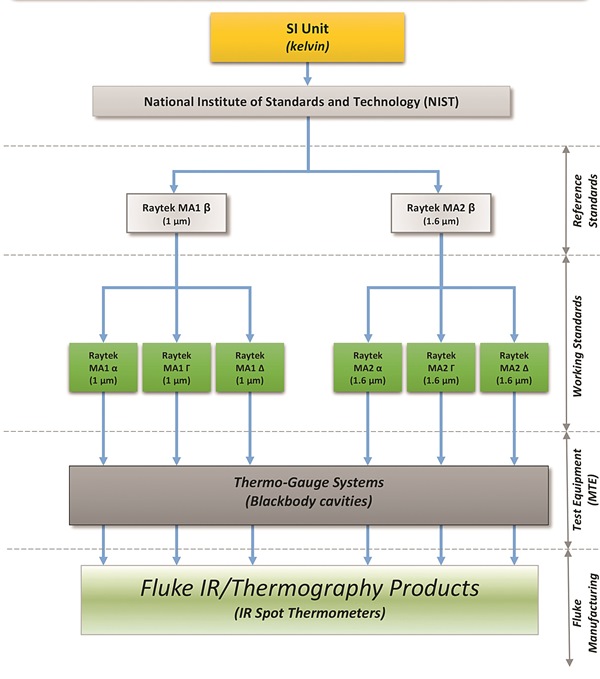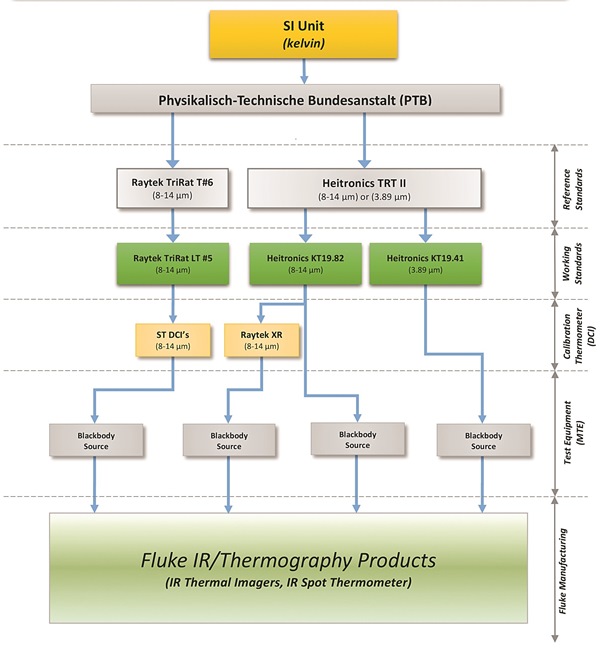By Slavik Moskalets
Corporate Metrologist for IR/Thermography
Fluke Corp.
Temperature inspection using infrared (IR) cameras and spot thermometers is becoming one of the quickest, safest ways to accurately inspect electrical, electronic, mechanical, HVAC, and process control systems. These instruments can pick up subtle—or not-so-subtle—temperature differences that spell trouble. They also allow the user to keep a safe distance from hot, hazardous, or moving targets.
To ensure their accuracy, IR cameras and IR spot thermometers like other instruments need to be calibrated. The standards used to calibrate them must be calibrated as well, by equipment that is also calibrated to a much better accuracy level. And so it goes, ultimately up to the International System of Units (SI) kelvin—the SI base unit of thermodynamic temperature. Metrological traceability is critical because accurate temperature measurements affect plant safety, process efficiency, material strength, product quality, equipment life, and more.
The kelvin was firmly established as the fundamental unit of temperature in 1967 by the General Conference on Weights and Measures (or CGPM, from the French “Conférence générale des poids et mesures”) and defined as the fraction 1/273.16 of the thermodynamic temperature of the triple point of water. The triple point of a material is when it exists simultaneously as a solid, liquid, and gas, which it can only do under specific temperature and pressure conditions; for water, the temperature is 0.01°C at a pressure of 6.1173 mbar. Responsibility for maintaining the SI base unit standard established by the CGPM resides in standards laboratories established by national governments.
Calibrating the calibrators
To standardize infrared calibration traceability for its organization, a dedicated laboratory, the Fluke IR Primary Reference Standards Lab, was opened in Everett, WA, in May 2015, after four years of development. The idea was to build a primary reference lab that could disseminate infrared traceability to the rest of the company’s’s infrared calibration laboratories worldwide. This lab maintains the company’s primary reference standards, calibrates the working standards, and realizes the traceability all the way from the SI base unit of Kelvin down to the customer product. The lab provides a space dedicated specifically to calibrating the infrared reference standards that are distributed to all Fluke factories and service centers around the world. It also provides much needed research and development space.
The measurements performed in the IR standards lab are accredited to the international standard ISO/IEC 17025 to support accredited calibrations at Fluke customer service centers. ISO/IEC 17025 is a voluntary standard, but some industries now require their IR calibrations to have this accreditation.
For high temperature applications, the traceability path starts at the U. S. National Institute of Standards and Technology (NIST); for low temperature applications, at Germany’s Physikalisch-Technische Bundesanstalt (PTB). The Fluke lab sends its primary reference standards to NIST or PTB, where their performance is measured, thereby establishing a chain of traceability to the SI base unit of kelvin. These devices are shipped in purpose-built containers to protect them from environmental and physical damage. Fluke performs rigorous confidence checks to help ensure that the accuracy of those standards has been maintained in transit.
Once returned to the infrared metrology lab, those primary reference standards are used to calibrate working standards—also called transfer standards (see figs. 1 and 2 ). Transfer standards, which include special optics and detectors, are used specifically to calibrate the black body cavity devices on the production floor or in the Fluke customer service center.

Fig. 1: For its high-temperature measurement products, Fluke sends its primary standards, the Raytek MA1 β and MA2 β, to NIST to establish traceability to the SI unit of kelvin, then calibrates Raytek working standards with which to calibrate test equipment.

Fig. 2: For its low-temperature measurement products, Fluke send its Raytek TriRat T#6 and Heitronics TRT II primary standards to PTB, then uses appropriate working standards to ensure traceability for its test equipment.
he black body radiator concept refers to an ideal temperature source that can absorb all incident electromagnetic radiation, at all wavelengths and angles of incidence. It also radiates all infrared energy according to Planck’s law. Since a perfect black body is not physically achievable, a near black body–also called “grey body”—is used. The Fluke IR Standards Lab owns several different designs of these devices which provide the “known” value to compare to unknown temperature values on the instruments being calibrated.
After tThe black body cavity devices are calibrated they are used to calibrate infrared thermography customer products during manufacturing. Calibration stations are set up in a circle with multiple infrared camera engines on the outside of the circle, each pointing to its own radiometrically calibrated black body on the inside. The correct geometry and physical alignment of the camera to the black body are critical to achieve accurate calibration results.
Each black body has a different temperature, ranging from 15°C to 400°C (59°F – 753°F) or higher depending on the IR camera being calibrated. The infrared engines slowly revolve around the black bodies and each takes a turn pointing at each black body to calibrate for that temperature. When the engines complete the circle, they are radiometrically calibrated and traceable to the SI base unit of temperature.
Advertisement
Learn more about Fluke





